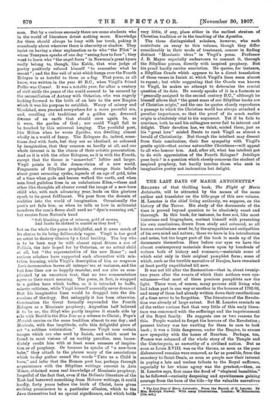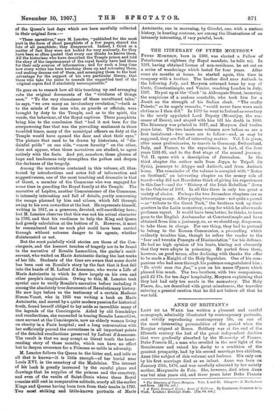THE LAST DAYS OF MARIE ANTOINETTE.*
READERS of that thrilling book, The Flight of Marie Antoinette, will be attracted by the names of the same author and translator on the title-page of this new volume. M. Lenotre is the chief living authority, we suppose, on the history of the Terror. His study of the documents of the time is proved beyond question to be absolutely exact and thorough. In this book, for instance, he does not, like most historians and biographers, content himself with presenting his own conclusions, drawn from study and coloured, as all human conclusions must be, by the sympathies and antipathies of his own mind and nature; these we have in his introduction and notes, but the larger part of the book is made up of the documents themselves. Here before our eyes we have the almost contemporary materials drawn upon by hundreds of writers both of history and romance,—materials some of which exist only in their original pamphlet form; some of which, such as the terrible narrative of Danjon, have remained at least partly unpublished till now.
It was not till after the Restoration—that is, about twenty- two years after the events of which their authors were eye- witnesses—that most of these precious pamphlets saw the light. There were, of coarse, many persons still living who had taken part in one way or another in the horrors of 1792-93, and many of them had already written down their recollections of a time never to be forgotten. The literature of the Revolu- tion was already of large extent. But M. Lenotre reminds us of the rather curious fact that very little of this early litera- ture was concerned with the sufferings and the imprisonment of the Royal family. He suggests one or two reasons for this. People wanted to forget the horrors of the Revolution ; present history was too exciting for them to care to look back ; it was a little dangerous, under the Empire, to arouse new sympathy with the house of Bourbon. Perhaps, too, France was ashamed of the whole story of the Temple and the Conciergerie, so unworthy of a civilised nation. But as soon as Louis XVIIL was on the throne, as soon as the poor dishonoured remains were removed, as far as possible, from the cemetery to Saint-Denis, as soon as people saw their interest in paying a late and useless tribute to the Royal sufferers, especially to her whose agony was the greatest,—then, as M. Lenotre says, first came the flood of "elegiacal banalities," to be followed—curiosity deepening and eyewitnesses gaining courage from the turn of the tide—by the valuable narratives • The Last Days of Maris Antoinette. From the French of G. Centre. By Mrs. Bodolph StawelL With many Illustratimm. London; W. Heinemann.. [10a. net.] of the Queen's last days which are here carefully collected in their original form :— "These narratives," says M. Lenotre, "published for the most part in the form of short pamphlets of a few pages, shared the fate of all pamphlets; they disappeared. Indeed, I think as a matter of fact they were not looked for very zealously, for they have been so often quoted that every one thinks he knows them. An the historians who have described the Temple prison and told the story of the imprisonment of the royal family have had these for their only sources of information ; and for such a long time now every writer has been touching them up and colouring them, and making dramas out of them, and arranging them to the best advantage for the support of his own particular theory, that those who take the pains to consult the ungarbled text of the original copies find it absolutely unrecognisable."
He goes on to remark how all this touching up and arranging robs the original documents of the " vividness of things
seen." " To the very clumsiness of these uncultured tales," he says, "we owe many an involuntary revelation,"—both as to the minds of the men who, as guards or officials, were brought by duty to the Temple, and as to the spirit, the words, the behaviour, of the Royal captives. These pamphlets bring him to the conclusion that " had it not been for the overpowering fear that was the prevailing sentiment in those troubled times, many of the municipal officers on duty at the Temple would have opened the door and shut their eyes." The picture that used to be drawn by historians, of "dis- dainful pride" on one side, "coarse ferocity" on the other, does not appear, when these narratives are studied, to agree entirely with the facts. And yet, somehow, these gleams of hope and tenderness only strengthen the pathos and deepen the darkness of the tragedy.
Among the narratives contained in this volume, all illus- trated by introductions and notes full of information and suggestiveness, one of the most touching and dramatic is that of Goret, a member of the Commune who was engaged for some time in guarding the Royal family at the Temple. The narrative of Lepitre, another Commissioner of the Commune, is intensely interesting and fall of details, partly concerning the escape planned by him and others, which fell through owing to his own cowardice at the last. He represents himself, writing in 1817, as a generous, devoted, self-sacrificing hero ; but M. Lenotre observes that this was not his actual character in 1793, and that his readiness to help the King and Queen had greedy calculation at the bottom of it. However, it must be remembered that no such plot could have been carried through without extreme danger to its agents, whether disinterested or not.
But the most painfully vivid stories are those of the Con- ciergerie, and the keenest touches of tragedy are to be found in the narrative of Rosalie Lamorliere, the gaoler's maid- servant, who waited on Marie Antoinette during the last weeks of her life. Students of the time are aware that some doubt has been cast on Rosalie's story by the fact that it first fell into the hands of M. Lafont d'Aussonne, who wrote a Life of Marie Antoinette in which he drew largely on his own and other people's imagination. Owing to this, M. Lenotre took special care to verify Rosalie's narrative before including it among the absolutely true documents of Revolutionary history. He now lays before us the testimony of a certain Madame Simon-Vouet, who in 1835 was writing a book on Marie Antoinette, and moved by a quite modern passion for historical truth, found herself obliged to lay aside as incredible many of the legends of the Conciergerie. Aided by old friendships and recollections, she succeeded in tracing Rosalie Lamorliere, once servant at the Conciergerie, now an elderly woman living on charity in a Paris hospital; and a long conversation with her sufficiently proved the correctness in all important points of the detailed recollections preserved by Lafont d'Aussonne. The result is that we may accept as literal truth the heart- rending story of those months, which can have no effect but to deepen reverence for a Princess so noble in adversity.
M. Lenotre follows the Queen to the bitter end, and tells us all that is known—it is little enough—of her burial near Louis XVL in the cemetery of the Madeleine. The interest Of hifi took is greatly increased by the careful plans and drawings that he supplies of the prisons and the cemetery, and even of the vaults of Saint-Denis where these Royal remains still rest in comparative solitude, nearly all the earlier Kings and Queens having been torn from their tombs in 1793. Twe most striking and little-known portraits of Marie
Antoinette, one in mourning, by Girodet, one, with a curious history, in hunting costume, are among the illustrations of an intensely interesting, if very painful, book.



















































 Previous page
Previous page